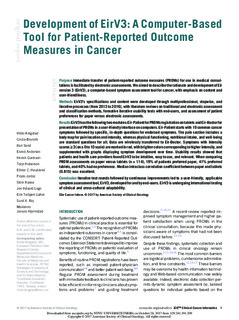| dc.description.abstract | Purpose
Immediate transfer of patient-reported outcome measures (PROMs) for use in medical consultations is facilitated by electronic assessments. We aimed to describe the rationale and development of Eir version 3 (EirV3), a computer-based symptom assessment tool for cancer, with emphasis on content and user-friendliness.
Methods
EirV3’s specifications and content were developed through multiprofessional, stepwise, and iterative processes (from 2013 to 2016), with literature reviews on traditional and electronic assessment and classification methods, formative iterative usability tests with end-users, and assessment of patient preferences for paper versus electronic assessments.
Results
EirV3 has the following two modules: Eir-Patient for PROMs registration on tablets and Eir-Doctor for presentation of PROMs in a user-friendly interface on computers. Eir-Patient starts with 19 common cancer symptoms followed by specific, in-depth questions for endorsed symptoms. The pain section includes a body map for pain location and intensity, whereas physical functioning, nutritional intake, and well-being are standard questions for all. Data are wirelessly transferred to Eir-Doctor. Symptoms with intensity scores ≥ 3 (on a 0 to 10 scale) are marked in red, with brighter colors corresponding to higher intensity, and supplemented with graphs displaying symptom development over time. Usability results showed that patients and health care providers found EirV3 to be intuitive, easy to use, and relevant. When comparing PROM assessments on paper versus tablets (n = 114), 19% of patients preferred paper, 41% preferred tablets, and 40% had no preference. Median intraclass correlation coefficient between paper and tablets (0.815) was excellent.
Conclusion
Iterative test rounds followed by continuous improvements led to a user-friendly, applicable symptom assessment tool, EirV3, developed for and by end-users. EirV3 is undergoing international testing of clinical and cross-cultural adaptability. | nb_NO |
